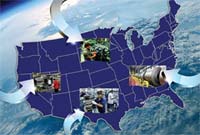Last week, I wrote a column on my take on the state of so-called Reshoring in the US based on many years of covering the topic in SCDigest and the release of consulting firm Kearny’s latest annual report on the topic. (See A Look at Reshoring 2025.)
My summary take then: Reshoring continues to be more anecdote-driven relative to a few successes (e.g., GE Appliances) and has never really shown up in the numbers in terms of US manufacturing output or trade deficits.
I had intended to move on to another topic for my column this week, when miraculously an article in the Wall Street Journal told the instructive and interesting story of how iconic marker maker Sharpie, through much effort, was able to make an unlikely success in bringing production back to US shores.
Here’s the summary.
Gilmore Says.... |
 |
| With additional investments in robots and training, the factory has been able to make pens at three to four times its previous speed, he said. The quality is better, too. |
 |
What do you say? |
|
| Click here to send us your comments |
| |
|
|
|
We all know Sharpie, the pens are a staple at home, at the office and at school. Its markers are simple and low cost - a perfect candidate for offshore production.
However, according to the Journal story, “Tucked in the foothills of Tennessee’s Smoky Mountains is a factory that has figured out a way to manufacture in America that’s cheaper, quicker and better.”
That quickly got my attention.
Today, Sharpie makes more than half a billion markers at its Tennessee factory every year, each one made of six parts. Only the felt tip is imported, from Japan.
However, back in 2018, many Sharpies were made offshore. That’s when Chris Peterson, who was the CFO of Sharpie parent company Newell, challenged his team to answer a question: How could they keep the company from becoming obsolete compared with factories in Asia?
“I felt like we had an opportunity to dramatically improve our US manufacturing,” he told the Journal.
Peterson is now the CEO. And these days, most Sharpies - in all 93 colors - are made at the domestic,37-year-old Tennessee factory. Newell did it without reducing the employee count, and without raising prices.
But to get to this situation took close to $2 billion in investment – including in robots - across the company, thousands of hours of training and a total overhaul of the production process.
“The result is a playbook for making low-cost, high-volume products domestically, albeit one that requires long-term planning and a lot of investment,” the Journal article says.
Is it a playbook? Filippo Falorni, an analyst at Citi, told the Journal few companies have the resources to replicate Newell’s move.
 “I really don’t think there’s anyone that can be as competitive as them,” said Falorni. “I really don’t think there’s anyone that can be as competitive as them,” said Falorni.
Newell began moving some Sharpie production to China in the 2000s, part of the wave of outsourcing by US companies looking to slash production costs.
By the time Peterson started his project in Maryville, TN, in 2018, the company had moved some of that production back to the US, but production rates for Sharpies here were low compared with competitor products made abroad.
Wages at the Maryville facility, which employs 550 workers, has gone up some 50% over the past five years -without a change in head count.
With additional investments in robots and training, the factory has been able to make pens at three to four times its previous speed, he said. The quality is better, too.
Last year, when Newell brought production of its retractable Sharpie back from China, engineers spent months designing the robotic system that turns barrels and clickers into fully assembled markers. Technicians figured out how to stop them from drying out—a problem that had plagued the version made in China - by sealing an internal chamber of the pen.
“It’s really night and day compared to when I first joined,” Peterson told the Journal adding that “There’s no longer a reason to manufacture Sharpie outside the U.S.”
So there you have it. Not a lot of detail, but a compelling story nevertheless.
It took a lot of cost and effort – I would like to see the ROI on that $2 billion investment in domestic production.
But my main takeaway from the Sharpie reshoring success is this: that kind of result may be less a matter of economics than of corporate will.
What is your take on Sharpe's reshoring? Let us know your thoughts at the Feedback button below.
Your Comments/Feedback
|